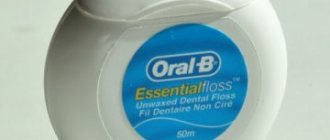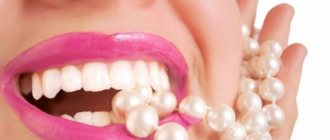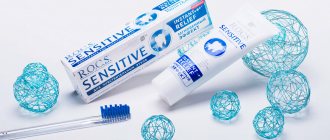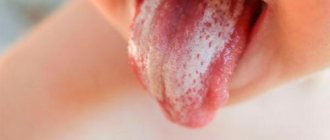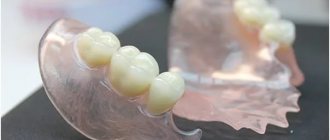Tongue brushing is an important part of oral hygiene and should be cleaned as often as your teeth. On the surface of the tongue there are numerous papillae, dimples and grooves in which microscopic food particles get stuck and bacteria accumulate, so the tongue is most susceptible to plaque. Regular tongue cleaning helps get rid of a huge number of pathogens that cause diseases of the oral cavity and teeth - glossitis, stomatitis, gingivitis, caries, periodontitis, etc.
Cleaning your tongue not only maintains hygiene, but also helps maintain a strong sense of taste. The tongue is responsible for the perception of taste. A pure language perceives it more clearly. You will discover new nuances of taste, and, oddly enough, you may start eating less.
In Ancient China, the nobility used a special tongue scraper before starting a feast. It was believed that cleansing the tongue helps to appreciate the true taste of food.
Why clean your tongue?
Although dentists unanimously insist on the importance of comprehensive oral care, including regular removal of bacterial plaque from soft tissues, not everyone understands why it is necessary to clean the tongue.
In this article
- Why clean your tongue?
- Is it possible to clean plaque from your tongue yourself?
- Is it possible to clean your tongue with a toothbrush?
- How to clean plaque from your tongue with a toothbrush?
- Preventive measures
Normally, in a healthy person, it has a pinkish color, but due to poor hygiene or for another reason it can become covered with a white coating.
There may be several reasons. One of the main ones is food debris getting stuck between the lingual papillae. In this environment, microbes actively multiply, forming plaque. It is partially washed off with saliva and partially removed when brushing your teeth. But if plaque-covered areas persist at the base of the tongue or in other hidden areas, then over time this film of bacteria will cover the entire tongue and may re-deposit on the teeth.
Plaque on the tongue causes the following problems:
- bad breath;
- increased risk of developing caries and tartar formation;
- disruption of the normal functioning of taste buds.
If you regularly remove plaque from your tongue, these problems can be prevented.
Secrets of fresh breath
A pleasant smell from your mouth is guaranteed by the comprehensive application of the methods mentioned above. However, there are additional tricks for exceptional cases:
- the stench after garlic and onions is perfectly masked by black tea, citrus fruits and walnuts. And if you chew celery or parsley, the smell will disappear completely;
- Rinsing your mouth with hot water and adding a couple of menthol crystals will help freshen your breath during menstruation;
- You can quickly and pleasantly kill the tobacco smell with a handful of fresh blackberries or dried acacia seeds. The fruits must be chewed thoroughly and only then swallowed;
- universal means of freshening breath are rinsing with decoctions of chamomile, oak bark, mint, strawberry leaves, wormwood, and St. John's wort.
It is important to realize that in most cases, bad breath is a signal from the brain about serious diseases of various organs and systems. Folk remedies are useless in such cases: they can temporarily mask the stench, but are unable to cure the cause. In such cases, it is necessary to immediately go to the hospital for a comprehensive examination. Only he will help identify the source of the disease and proceed to treatment.
Is it possible to clean plaque from your tongue yourself?
A healthy person's tongue normally has a pink tint and is slightly moist. With improper hygiene, a physiological white coating can form on its surface, which can be easily removed by yourself. But in some cases, the reasons for the formation of microbial film are pathological. This could be an infectious disease, periodontal disease and any inflammatory processes in the oral cavity, disturbances in the gastrointestinal tract or respiratory system, or decreased immunity. If the reason for the appearance of a film on the tongue is pathological, in this case it would be correct to seek help from a dentist.
The following signs will help you understand whether the film on the tongue is a normal physiological condition or a symptom of some disease.
"Healthy" plaque:
- yellowish or white;
- covers the tongue with a thin layer, through which the lingual papillae are visible;
- there is no pungent odor from the mouth or pain;
- appears periodically, due to some factors (for example, thirst);
- it can be easily removed with a brush.
Signs that indicate pathology:
- grey, brown or yellow;
- lies in a dense opaque layer;
- has a sour or bitter taste;
- It cannot be removed with a brush.
Healthy and unhealthy coating on the tongue: how to determine
Even in the time of Hippocrates, healers asked patients to stick out their tongues. By assessing the thickness and color of the organ, doctors made conclusions about the state of human health. Centuries have passed, but this method of primary diagnosis is still used by many therapists, dentists, pediatricians, and otolaryngologists.
The plaque itself does not cause disease. It has various causes for its formation: poor hygiene, smoking, dyes in products, diseases of the teeth and oral cavity. If you are healthy, do not be surprised by the appearance of deposits on your tongue in hot weather, in the morning after waking up, or during the day after eating. This is normal and should not cause concern. The pale pink coating has almost no odor, changes color when using coloring products, and is easily removed with proper hygiene.
Pathology is considered to be a very dense coating through which the color of the tongue is not visible. Usually the deposits smell unpleasant, redness and cracks are visible on the surface, and after cleansing the condition of the tongue does not change. Unhealthy plaque can be brown, green, yellow and even black.
Is it possible to clean your tongue with a toothbrush?
You can remove the white film from the surface of your tongue with a toothbrush, either manual or electric. To remove plaque, use a toothbrush to move it from the base to the tip of your tongue.
There are other ways to remove physiological plaque without the help of a dentist.
- Special scrapers.
They are made of plastic and can be V-shaped or loop-shaped. They are very easy to use. It is enough to place them at the root of the tongue and slowly move it to the tip, removing the bacterial film. At the end of the procedure, you need to rinse your mouth with water or a special antibacterial product. Modern scrapers are designed to clean the surface of the tongue gently and delicately, without provoking a gag reflex or discomfort.
- Irrigators.
These devices care for the oral cavity using a directed stream of water. They clean interdental spaces, crowns and dentures, and also perfectly clean the surface of the tongue using a special attachment in the form of a spoon or spatula.
- Spoons.
If you don't have an irrigator, you can use a special spoon with rounded edges. You can easily find it in any pharmacy. The cleaning principle is the same - from base to tip with light pressure.
- Herbal rinses.
Decoctions of sage, calendula, and propolis help to cope with plaque. But they only complement the effect of mechanical cleaning and can be used for prevention.
How to protect your gums
According to statistics, 75% of the world's population has gum disease. It is noteworthy that the proportion of people suffering from periodontal diseases in underdeveloped countries is several times smaller than in the most progressive societies. Scientists cannot yet explain this phenomenon.
The mucous membrane surrounding the enamel is the most sensitive and, unfortunately, weak to external irritants. Cleaning your gums is closely related to dental hygiene, but also requires additional care:
- You need to rinse your mouth with warm salted water with the addition of soda at least twice a week. The liquid must be retained by slowly passing through clenched teeth for 5-7 minutes;
- It is extremely useful to massage your gums with a mixture of kitchen or sea salt with fresh flower honey. The pulp should be gently rubbed at the base of the teeth for 6-8 minutes, then rinsed with running water;
- hardening of mucous tissues with whole carrots is invaluable. This is the case when it is not possible to overdo it;
- it is necessary to breathe through the mouth as little as possible, this dries out and weakens the gums;
- Ordinary sauerkraut has an amazing effect on the gums. Its regular use is more beneficial than all the methods listed above.
How to clean plaque from your tongue with a toothbrush?
Not everyone wants to buy separate devices to remove plaque from the tongue, so for many the question is how to carry out this procedure with a regular brush. To properly and effectively clean your tongue with a toothbrush, you need to follow simple recommendations:
- Tongue cleaning begins at the very end - when the teeth, interdental spaces and other areas of the oral cavity are brushed.
- First, the tongue is cleaned with a brush from base to tip, the plaque is removed with a uniform, smooth movement in one direction. Then brush across the tongue and from tip to base. It is necessary to repeat the movements in all directions at least four times.
- Typically, cleaning the tongue is combined with cleansing the inner surface of the cheeks: they are also brushed over it without strong pressure.
- Finish cleaning by rinsing. To do this, use antibacterial oral fluids.
Note that you can clean your tongue with both manual and electric brushes. For the second, you need to purchase a special attachment; with a regular brush, the reverse side of the cleaning head with a special relief coating is used for this purpose.
Benefits of tongue cleaning
A number of studies prove that regular tongue cleaning is as necessary as brushing your teeth and the entire oral cavity.
Benefits and results of tongue cleaning:
- Less susceptibility to infectious diseases of the oral cavity 2.
- Preventing ingestion of accumulated plaque.
- Removing more bacteria 2.
- Eliminating or reducing unpleasant odor 3.
- Increasing the sense of taste, which means satiation with less food.
Preventive measures
It is easier to prevent the formation of plaque on the tongue than to treat its pathological form. The following preventive measures will help with this:
- Perform comprehensive oral hygiene morning and evening.
- Monitor the condition of the gastrointestinal tract and treat diseases of the digestive system in a timely manner. They are most often the cause of pathological plaque.
- Stop smoking and drinking alcohol.
- Consume spices, smoked and spicy foods in moderation.
- Treat caries and other dental diseases in a timely manner. Get preventive examinations at the dentist.
- Drink more and eat vegetables and fruits with a high fluid content, because dehydration can be the cause of plaque on the tongue.
Thus, brushing the tongue is an important part of oral care. It helps to avoid the problem of bad breath, reduces the risk of developing inflammation in the mouth and serves as a prevention of dental diseases. Plaque can be removed in different ways, including with a regular toothbrush. In addition, it is necessary to follow preventive measures to avoid the appearance of pathological plaque.
What does it mean if your entire tongue changes color?
The plaque usually differs in that it does not cover the entire tongue, but only part of it, closer to the middle, although sometimes this spot increases in size. In most cases, plaque is not dangerous.
It's a completely different matter if the tongue has changed color completely, from all sides. This may be a sign of serious problems in the body. Which ones can be guessed based on the Tongue Color.
- Violet. It is a symptom of circulatory disorders, even a heart attack. Sometimes a purple tongue also reports Kawasaki disease, which is associated with inflammation of the blood vessels.
- Bright red. May indicate vitamin B deficiency, scarlet fever, or an allergic reaction to some medicine or food product. In rare cases, a scarlet, “strawberry” tongue again indicates Kawasaki disease.
- Bluish. This shade indicates a lack of oxygen in the blood. The cause of this may be diseases of the lungs, blood, blood vessels, and kidneys. All of these conditions require immediate medical attention.
- Very light pink, whitish. May be a sign of Tongue Discoloration and Other Changes of anemia.
A changed color of the tongue is a clear indication to consult a therapist as quickly as possible. Or even call an ambulance if, in addition to changes in color, other threatening symptoms are observed: for example, chest pain radiating to the arm or jaw, darkening in the eyes, severe dizziness, difficulty breathing.
How is plaque formed?
Epithelial cells on the surface of the tongue are constantly exposed to fairly aggressive factors: acidic foods, temperature changes, bacteria. That is why their lifespan is not long and after they are exfoliated, young cells appear. If the processes of changing cellular layers are excessively active, then the upper layers do not have time to peel off and remain on the surface of the mucosa in the form of plaque.
Another factor in the formation of plaque can be microorganisms. Children often do not pay enough attention to oral hygiene, as a result of which microscopic particles of food can remain between the lingual papillae, which become a place for active reproduction of bacteria. Taking antibacterial drugs often provokes the growth of pathogenic microflora in the mouth (fungi), some varieties of which are quite brightly colored.

